Passenger Boarding Bridge Market Overview, 2031
The global passenger boarding bridge market was valued at $310.5 million in 2021, and is projected to reach $1,033.9 million by 2031, growing at a CAGR of 12.7% from 2022 to 2031. A passenger boarding bridge (PBB), also known as an air bridge, jet bridge, jetway, and sky bridge, is an enclosed, elevated passageway that extends from an airport terminal gate to an airplane. This aerobridge benefits the passenger to travel safely from the airport terminal to the aircraft and protects them from weather conditions. It also improves security by limiting access to aprons and operational areas. Passenger boarding bridges can be found in many configurations and may be fixed or movable, depending upon the installation.
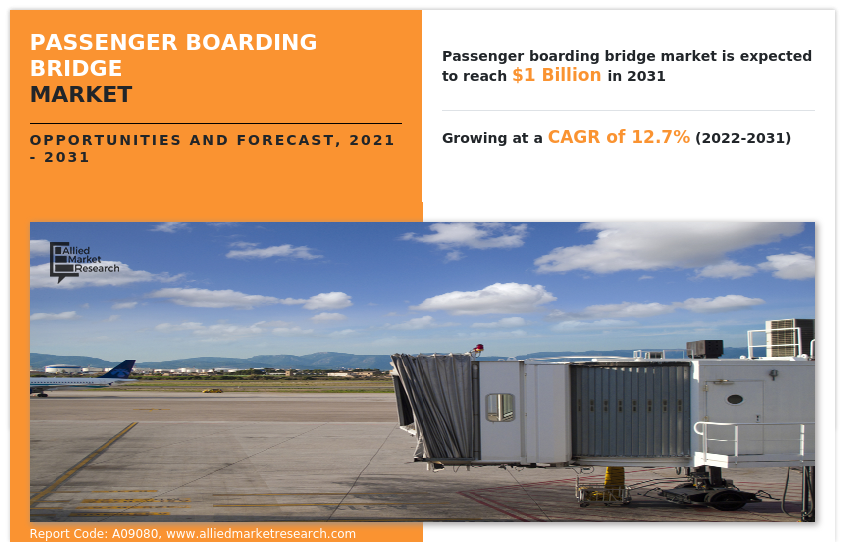
Nowadays, modern techniques such as mobile units are used to faster the aerobridge from one terminal end to another. These units are height adjustable and can be used by multiple aircraft. For instance, ShinMaywa Industries in Japan has developed AI technology to place passenger boarding bridges automatically as close to 10 cm at aircraft doors, which is far closer than the current present models in the passenger boarding bridge market. Moreover, at inter airport Europe 2019, ADELTE relaunched Apronaut. It is the first software-based passenger boarding bridge (PBB) docking simulator in the world to offer rigorous training in a nil-risk environment for PBB operators. This PBB docking simulator enables staff to practice, dock, activate, and dock on all types of aircraft repeatedly.
The factors such as rise in aviation passenger traffic, increase in demand for large aircraft, and launch of upgraded products to improve infrastructural growth supplement the growth of the passenger boarding bridge market. However, long time life cycle for replacement of passenger boarding bridges and dearth of skilled workforce are the factors expected to hamper the growth of the passenger boarding bridge market. In addition, rise in greenfield and brownfield airport projects and modernization of airports create market opportunities for the key players operating in the passenger boarding bridge industry.
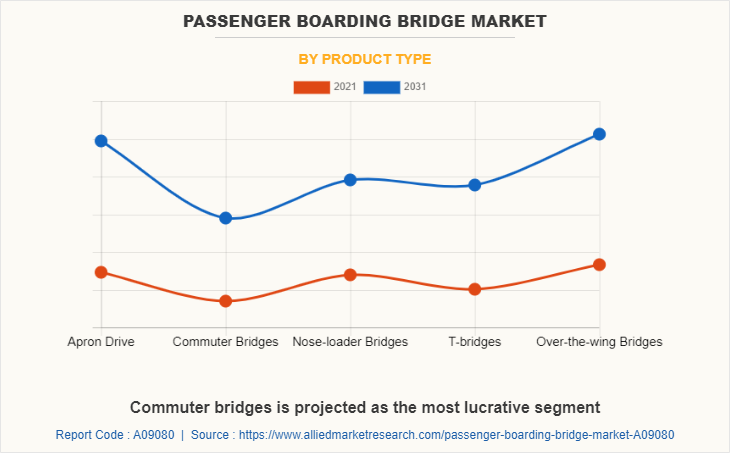
The passenger boarding bridge market is segmented into product type, structure, elevation system, tunnel type, foundation, and region. On the basis of product type, the passenger boarding bridge market is divided into apron drive, commuter bridges, nose-loader bridges, T-bridges, and over-the-wing bridges. On the basis of structure, it is fragmented into glass-walled, steel-walled, and glass-steel-walled. On the basis of elevation system, it is categorized into hydraulic and electro-mechanical. On the basis of tunnel type, it is further classified into air-conditioned and non air-conditioned. On the basis of foundation, the passenger boarding bridge market is divided into fixed and movable. On the basis of region, it is analyzed across North America, Europe, Asia-Pacific, and LAMEA.
The leading players operating in the passenger boarding bridge market are A-Bridge LLC, AccessAir Systems, Inc., ADELTE Group S.L., Airport Equipment, Avicorp Middle East, Bukaka Group, China International Marine Containers, Deerns, FMT Sweden AB, HÜBNER GmbH & Co. KG, JBT Corporation, Mitsubishi Heavy Industries, Ltd., NAFFCO Aviation, ShinMaywa Industries, Ltd., Thyssenkrupp AG, UBS, and Vataple Group.
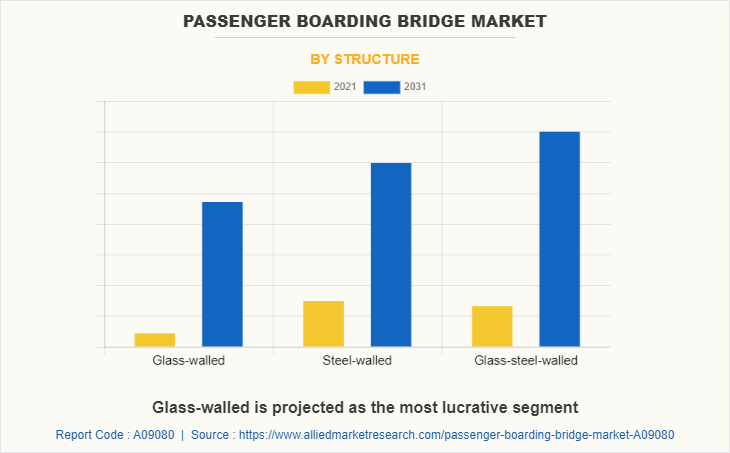
Rise in aviation passenger traffic
According to the International Civil Aviation Organization (ICAO), by 2035, passenger traffic and freight volume should be double. Factors such as growth in disposal income of the middle-class population and the emergence of low-cost airlines have led to an increase in number of airline passengers. Major countries such as Canada, U.S., Brazil, Indonesia, Philippines, China, Saudi Arabia, and India witnessed rise in number of air passengers. For instance, according to the Bureau of transportation, in October 2021, U.S. Airlines’ passengers increased 119% from October 2020. According to International Air Transport Association (IATA), passenger numbers could double to 8.2 billion in 2037 at 3.5% compound annual growth rate (CAGR). Therefore, an increase in aviation passenger traffic indirectly is expected to boost the demand for passenger boarding bridge market. Participants of the aviation industry need to use analytical solutions to predict customer preferences, reduce operational cost, manage fuel cost, and others with increment in passenger traffic will generate an enormous amount of information.
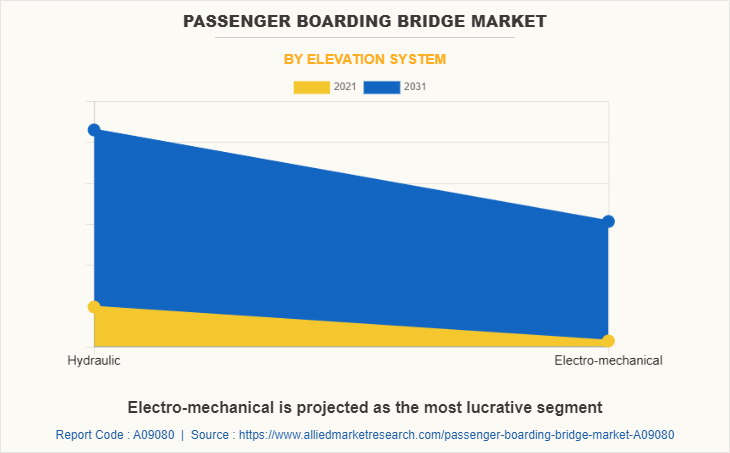
Increase in demand for large aircraft
As increment in passenger traffic is projected to generate an enormous amount of information, participants of the aviation industry need to use analytical solutions to predict customer preferences, reduce operational cost, manage fuel cost, and others. To address this growing passenger traffic, several airlines are now buying large aircrafts to accommodate more passengers onboard single trips. Airlines are ordering large aircraft such as the Boeing 747-8 and the Airbus A380. Following this increase in the number of exceptionally large aircraft (VLA) deliveries, airport boarding areas gates now must accommodate more passengers per gate per flight. Boarding all passengers using passenger stairs is time consuming and could result in loss of potential revenue as the turnaround time of an aircraft increases. Passenger boarding bridges cater to these problems efficiently and conveniently, which drives their passenger boarding bridge industry, especially for use on large aircraft.
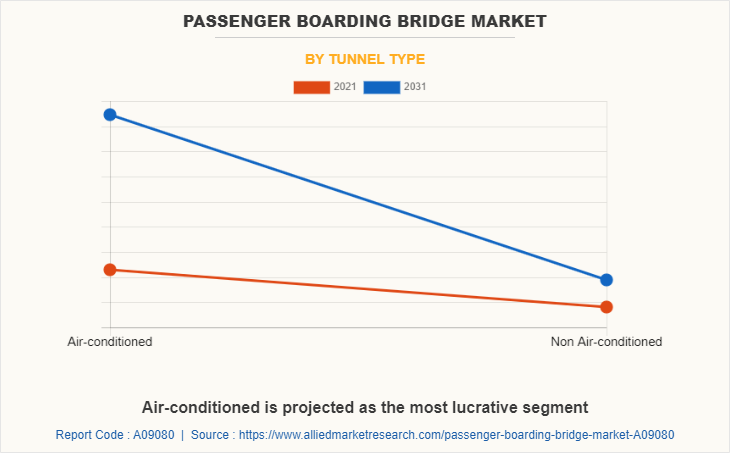
Long time life cycle for replacement of passenger boarding bridges
Passenger boarding bridges (PBBs) were introduced in 1959 at the San Francisco international Airport (U.S.). A typical aerobridge serves for 15 to 20 years after which it is replaced. The installation of new PBBs largely depends on upcoming airport construction and modernization programs. Also, the airport authority tends to opt for the refurbishment of aerobridges as it provides an expected lifespan of 8 to 10 years at half the cost of a new PBB. Moreover, it provides airports with the possibility to upgrade and customize PBBs in terms of appearance and performance. The cost of buying new PBBs and their installation is high when compared to the refurbishment of the existing ones. Apart from this, the time needed to order, procure, and install a PBB is also a restraining factor.
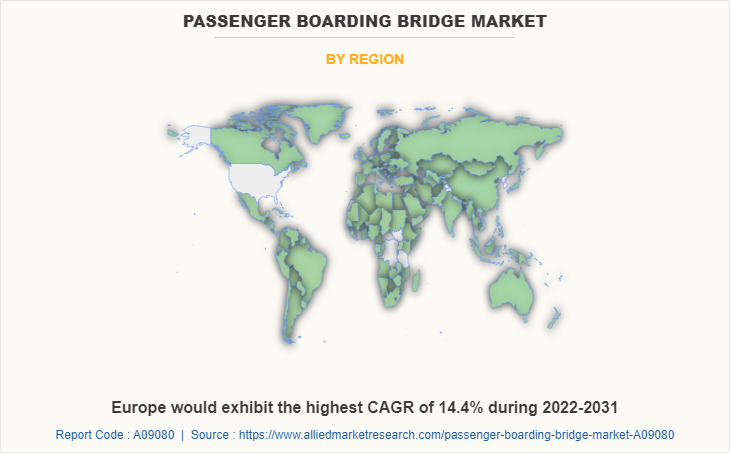
Rise in greenfield and brownfield airport projects
Greenfield airport project is a terminology defining construction of new airports on a greenfield land, whereas brownfield airport involves modification or upgrade of airports as per the global standards. Continuous rise in greenfield and brownfield airport projects in developing economies is expected to provide lucrative opportunities for the passenger boarding bridge market. For instance, The Airport Infrastructure in India has witnessed improvisation and expansion of airports on a massive scale due to increase in support from private participants.
The government of India has received proposals for setting up greenfield and brownfield airports at various places across the country to improve connectivity and boost economy. Hence, rise in greenfield and brownfield airport projects in developing economies is expected to create lucrative opportunity for the passenger boarding bridge market.
Key Benefits For Stakeholders
This study presents analytical depiction of the global passenger boarding bridge market analysis along with current trends and future estimations to depict imminent investment pockets.
The overall passenger boarding bridge market opportunity is determined by understanding profitable trends to gain a stronger foothold.
The report presents information related to the key drivers, restraints, and opportunities of the global passenger boarding bridge market with a detailed impact analysis.
The current passenger boarding bridge market is quantitatively analyzed from 2022 to 2031 to benchmark the financial competency.
Porter’s five forces analysis illustrates the potency of the buyers and suppliers in the industry.
Passenger Boarding Bridge Market Report Highlights
| Aspects | Details |
| Market Size By 2031 | USD 1 billion |
| Growth Rate | CAGR of 12.7% |
| Forecast period | 2021 - 2031 |
| Report Pages | 312 |
| By Product Type |
|
| By Structure |
|
| By Elevation System |
|
| By Tunnel Type |
|
| By Foundation |
|
| By Region |
|
| Key Market Players | ShinMaywa Industries Ltd, FMT Sweden AB, Hubner GMBH & CO KG, Deerns, UBS Airport Systems, NAFFCO Aviation, Vataple Group Ltd, CIMC Group Ltd., Airport Equipment, Ameribridge, ACCESSAIR Systems Inc, Adelte Group, PT Bukaka Teknik Utama Tbk, Mitsubishi Heavy Industries, JBT Corporation, Thyssen Krupp AG, Avicorp Middle East |
Analyst Review
This section provides the opinions of various top-level CXOs in the global passenger boarding bridge market. With increasing spending on airport infrastructure, especially across developing countries such as India, China, and Japan, governments are installing artificial intelligence (AI)-equipped passenger boarding bridges. For instance, in October 2020, Civil Aviation Minister of Chandigarh, India, installed and inaugurated two passenger boarding bridges at Chandigarh International Airport. These passenger boarding bridges are built to protect passengers from harsh weather and provide safety.
Furthermore, the increase in international passenger traffic has forced government agencies around the world to make substantial investments to expand their transportation networks so as to accommodate the high volume of visitors. According to the ICAO, international air traffic in North America in 2021 was recorded to be 92%, and it is expected to continue rising through 2022. On account of this, the government in the U.S. are enhancing the safety of the passengers and upgrading the airport infrastructure. Also, public-private partnership in the aerospace industry leads to capital investments, developing of air services, increasing airport commercial activities, and improving customer service for competitiveness, which in turn propels the market demand in the forecast period.
The market growth is supplemented by factors such as rise in aviation passenger traffic, increase in demand for large aircraft, and launch of upgraded products to improve infrastructural growth supplement the growth of the passenger boarding bridge market. However, long time life cycle for replacement of passenger boarding bridges and dearth of skilled workforce are the factors expected to hamper the growth of the passenger boarding bridge market. In addition, rise in greenfield and brownfield airport projects and modernization of airports creates market opportunities for the key players operating in the passenger boarding bridge market.
Among the analyzed regions, Asia-Pacific is the highest revenue contributor, followed by North America, Europe, and LAMEA. On the basis of forecast analysis, Europe is expected to lead during the forecast period due to the increase in passenger traffic in the region and the rise in the demand for large aircraft; as a result, to accommodate a large number of passengers over a single trip.
The global passenger boarding bridge market was valued at $310.5 million in 2021, and is projected to reach $1,033.9 million by 2031, registering a CAGR of 12.7% from 2022 to 2031.
The leading players operating in the passenger boarding bridge market are A-Bridge LLC, AccessAir Systems, Inc., ADELTE Group S.L., Airport Equipment, Avicorp Middle East, Bukaka Group, China International Marine Containers, Deerns, FMT Sweden AB, HÜBNER GmbH & Co. KG, JBT Corporation, Mitsubishi Heavy Industries, Ltd., NAFFCO Aviation, ShinMaywa Industries, Ltd., Thyssenkrupp AG, UBS, and Vataple Group.
The sample for passenger boarding bridge market report can be obtained on demand from the website. Also, the 24*7 chat support and direct call services are provided to procure the sample report
Introduction of Glass-Steel-Walled boarding bridges are the upcoming trends of Passenger Boarding Bridge Market in the world
Asia-Pacific is the largest regional market for Passenger Boarding Bridge
Loading Table Of Content...



